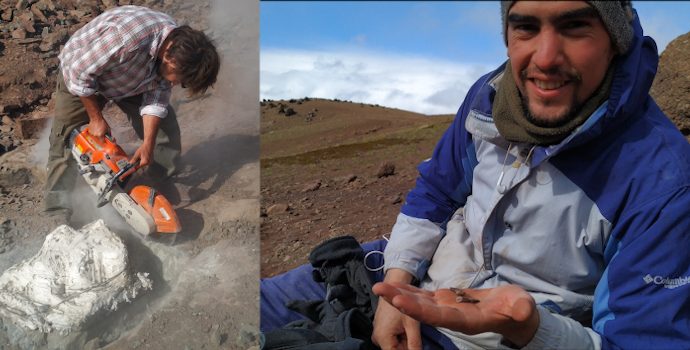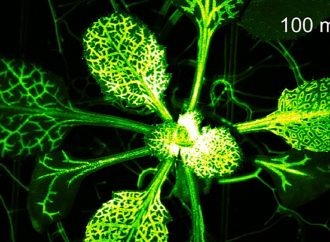Researchers from the Museo Argentino de Ciencias Naturales (Buenos Aires) found a large carnivorous dinosaur of about 70 million years old in the southwest of the province of Santa Cruz. From the specimen were recovered vertebrae, ribs and parts of the chest and shoulder girdle.
Source: Agencia CTyS
During 15 days, rescue tasks were carried out to extract this huge predator. Surely, from these fossils, researchers will be able to make known to the public this new large species pertaining to this group of carnivorous dinosaurs (megaraptors) that shows lethal characteristics to hunt their preys.
The paleontologist Mauro Aranciaga Rolando told to CTyS-UNLaM Agency: “We have found a very large specimen of a new megaraptorid, which were formidable carnivorous dinosaurs, because they had a set of adaptations for hunting that was amazing”.
“Unlike the Tyrannosaurus rex, the megaraptors were fast animals, more prepared for running to high speeds, with long tails that allowed them to maintain balance, at the same time that they had powerfull and long legs that were able to take long steps”, said Aranciaga Rolando, a PhD student from CONICET (MACN).
The megaraptorans had several characteristics that allows us to describe them as lethal. According to Aranciaga, “the main weapons of the megaraptors were their arms, because they were extremely long and powerfull, ending in a had scythe-like claw on their thumbs, which has a sharp edge and reached 40 centimeters in length. That´s why we think that this animal has conferred deep hurts against its preys”.
Dr. Fernando Novas, head of the MACN Laboratory of Comparative Anatomy and CONICET researcher, commented to the CTyS-UNLaM Agency that “this new finding will allow us to know better about the anatomy of these dinosaurs and to know their relations of kinship with the megaraptors found in other parts of the world as well as other dinosaurs”.
The paleontologist Novas was who discovered the first specimen of this group of dinosaurs in 1996, in the province of Neuquén, and it was he who coined the name Megaraptor (“huge raptor”) for this creature.
Megaraptors were large predatory dinosaurs that thrived and diversified during the Cretaceous period, primarily in the southern hemisphere, until the mass extinction that occurred about 65 million years ago. Also, megaraptors were also found in Australia and Asia.
“For me, it was a great satisfaction that, since we made that first discovery in Neuquén, cousins of the Megaraptor were found in other regions of the world,” said Novas. And he highlighted: “Now, we add another megaraptor from Patagonia”.
Aranciaga Rolando asserted that “this possible new species of about 10 meters long, in addition to its importance due to its huge size, represents one of the most modern specimens of the megaraptors family, since those that were known so far were some millions of years older”.
Another of the characteristics that Aranciaga Rolando indicated as favorable for the predatory aptitude of the megaraptors is that they had an elongated neck and skull, which surely helped them to reach their prey more easily.
Dinosaur racing
The possibility to sprint would have been very important for the megaraptors. The paleontologist Sebastián Rozadilla of the MACN and CONICET indicated that “these carnivorous dinosaurs would not have fed on the sauropods, which are those large long-necked dinosaurs that also lived in that area, but on other herbivorous dinosaurs of which was also found in the Chorrillo formation, west of Santa Cruz”.
“These herbivorous dinosaurs could reach between five and six meters in length and belonged to the Isasicursor species, which were bipeds and great runners”, said Rozadilla. Hence, the speed of the megaraptorans would have been an important factor in being able to hunt them down.
These herbivorous dinosaurs lived in large groups, including young and adults. “They lived similarly to the way gazelles or antelopes do today in the African savannah”, Rozadilla described.
The rescue of this great predator
The smallest known megaraptorans measure about five meters, while the largest are similar to this specimen found southwest of Santa Cruz during the last campaign carried out in March.
To extract this animal, which was in extremely hard rock, it was necessary to use appropriate machinery such as the rock cutter.
In a task that took about two weeks, with chisels and hammers, paleontologists removed the rock surrounding the specimen in order to remove each of the bones. “Finally, the rock that contained the fossil was covered with plaster and bandages, so that it would not be destroyed during its transportation to Buenos Aires”, said Aranciaga.
For these weeks, this formidable predator is duly fulfilling his quarantine at the MACN Laboratory of Comparative Anatomy, waiting for the researchers to continue with their preparation and study. Subsequently, this sprinter will make his trip back to the province of Santa Cruz to enrich the collections of the “Padre Molina” Museum, in Río Gallegos.
Source: Agencia CTyS

































Leave a Comment
You must be logged in to post a comment.